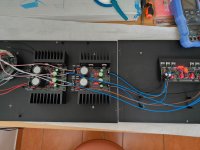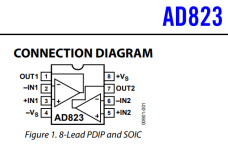Wrong place for that discussion, I think. 😊www.diyaudio.com/community/threads/help-with-w-one-ladder-relay-attenuator-remote-control.427834/#post-8028818
Patrick
Patrick
I’ve got a pair of ACA monoblocks and in process of gathering all the parts for a My_Ref FE amp. I know the ACA’s need the preamp, but what’s the opinion on using the DCG3 with possibly a gain switch to use it for both? Would it be easy to put a pair of RCA outs for passive volume control of the My-Refs utilizing the volume control and iSelect in a DCG3 pre? Trying to think of the best way to do this so I don’t have to be swapping cables all the time if I want to switch amps. I’d originally thought of using a Mesmerize, but I’m not sure it’d work with the ACAs.
Hi, its possible to tap from the i-select for no gain outputs, but it would be preferable to also add a unity gain capable op-amp buffer stage in-between. To isolate the rest and potently drive the interconnects. A gain switch wired to the front panel is possible to pick up noise because in the feedback path. The DCG3 can't be set to less than 6dB gain anyway.

Thanks Salas. I’ll have to think on that. I really want to utilize the selector source options for both amps. I know I can direct in (no preamp) with the My_Ref, but I’d like the ability to switch sources. A single preamp/selector would be ideal, but maybe not the best option in the end in this situation. I’m not sure if 6dB gain will be too much for the My_Ref, although I might be able to adjust the input on the amps slightly to help with that situation. That’s one reason I thought a gain switch would possibly be useful. Still lots to learn.
If on the fly gain changing is not required, but to use different power amps between time periods, you could alternatively install female pins to can swap R6 resistor values for different gain setting.
Test run SSLV 1.3 Shunt reg + DCG3, all test points OK, dc offset normal. The heatsinks are only slightly warm, bias 110mA. I am satisfied 🙂
@Salas Before inserting the dc servo into the socket I trimmed both channels to about 1mV after 15 min. After inserting the dc servo and cold dcg3 one channel shows approx 25mV, after settling the temperature for approx 10min it drops to 3mV, the other channel is still below 1mV. Is this deviation OK, I would rather blame it on the manufacturing deviation of the AD823 😡
If I would like to try another operational amplifier on the dc servo position for peace of mind, which do you recommend from the available ones?
@Salas Before inserting the dc servo into the socket I trimmed both channels to about 1mV after 15 min. After inserting the dc servo and cold dcg3 one channel shows approx 25mV, after settling the temperature for approx 10min it drops to 3mV, the other channel is still below 1mV. Is this deviation OK, I would rather blame it on the manufacturing deviation of the AD823 😡
If I would like to try another operational amplifier on the dc servo position for peace of mind, which do you recommend from the available ones?
Attachments
Last edited:
Hi, no, 25mV its not normal after inserting the servo op-amp. Even if it settles to 3mV eventually. 1mV right away or below is normal. Like in the other channel.
Short each line input to GND first to make sure it isn't about interference. Check that the servo chip in the high offset channel is inserted with the right orientation and its pressed down in the socket properly.
If the situation doesn't change, swap AD823 servo chips to see if the high offset follows one certain chip or not. If it does, then its a rogue op-amp sample.
The inexpensive ubiquitous TL072CP added some noise vs modern better spec types in my lab tests but it still controlled offset well for a comparison. And it didn't interfere with the tone in a bad way.
Short each line input to GND first to make sure it isn't about interference. Check that the servo chip in the high offset channel is inserted with the right orientation and its pressed down in the socket properly.
If the situation doesn't change, swap AD823 servo chips to see if the high offset follows one certain chip or not. If it does, then its a rogue op-amp sample.
The inexpensive ubiquitous TL072CP added some noise vs modern better spec types in my lab tests but it still controlled offset well for a comparison. And it didn't interfere with the tone in a bad way.
Today I measured the ad823 with an ohmmeter, good channel between pin 1 and 2pin (7,7Mohm) 1 and 3pin (7,7Mohm), faulty channel shows no value between pins 7 and 6 as well as 7 and 5. So obviously it's a defective piece 😢
At the end of the week I will order some parts for UltraSFP, so I will add AD823 to my cart 🙂
At the end of the week I will order some parts for UltraSFP, so I will add AD823 to my cart 🙂
Attachments
I noticed in a couple of AD823 that your test method needs the black probe on an output pin (1 or 7) to show some MΩ relative to associated input pins. Else it shows "overload" i.e. open circuit. Just make sure red on 7 wasn't the case.

It's starting to take shape,

Salas, beautiful collection of OP-Amp.
Salas, beautiful collection of OP-Amp.
i have the same problem approximately with 1656 opamp. Now i use double OPA604 like photos Nick and settle it down after one minute to R=0.2V and L=0.6V channel . Full bass and details....@Salas Before inserting the dc servo into the socket I trimmed both channels to about 1mV after 15 min.
Last edited:
Looking forward to hearing some cap swapping results.
0.2mV and 0.6mV you mean? I tested OPA2604 (dual 604) during the DCG3's development as well. Gave good offset control and subjectively bit livelier bass and treble than neutral. Full and detailed could be another description as you say. One thing is it was working hotter than other chips due to its high +/- 10.5mA typical spec bias. It could also allow higher PSU rails because it has +/-24V max spec. But not too practical of an option due to its dissipation. Stick-on mini sinks used to be available for op-amps though if I am not mistaken.i have the same problem approximately with 1656 opamp. Now i use double OPA604 like photos Nick and settle it down after one minute to R=0.2V and L=0.6V channel . Full bass and details....
Hi Tea,Yes, me too,Looking forward to hearing some cap swapping results.
on the advice of Salas,for the synergy between UBIB and DCG 3,something to amuse me for a while😉
P.S Sorry for the quality of the photo, the next ones will be better.
Hi Salas, I will be ordering some mechanical parts from Audiophonics and I am considering getting the OPA1642 and OPA1656. Have you tried them in the DC servo position by any chance?
https://www.audiophonics.fr/en/opa/audiophonics-opa1642-aop-double-dip8-p-19371.html
https://www.audiophonics.fr/en/opa/audiophonics-opa1656idr-opa-dual-dip8-p-19311.html
or stay with the proven AD823?
Thanks
https://www.audiophonics.fr/en/opa/audiophonics-opa1642-aop-double-dip8-p-19371.html
https://www.audiophonics.fr/en/opa/audiophonics-opa1656idr-opa-dual-dip8-p-19311.html
or stay with the proven AD823?
Thanks
Hi, any dual op-amp JFET input, low offset, low noise characterized type should work. No I don't have previous experience as servo chips on the DCG3 with those two. The 1656 is CMOS technology though (clue is its referred as FET not JFET). Since the 1642 is only 4.90 Euro already on a DIP-8 adapter in audiophonics, get one and try it to see how you like it. The AD823 was chosen due to keeping the DCG3 sounding closest to servo-less i.e. before inserting various op-amps. By my subjective impressions. But the 1642 wasn't on the scene at that time.
Now I remembered a friend with a balanced DCG3 who had tested modern super low THD JFET op-amps, not sure if there was a 1642 also included, but he reported he made a circle and returned to the AD823. So in any case have one 823 for subjective servo comparison. Its a system synergy thing also where mileages may vary.or stay with the proven AD823?
Thanks
OK, I won't speculate so I'll stick with the proven AD823.
So if the DC servo is affecting the sound so significantly, the best solution would be not to use a DC servo, not to put a relay and circuit around it and use SSR protection (incl dc protect and delayed switch-on).
So if the DC servo is affecting the sound so significantly, the best solution would be not to use a DC servo, not to put a relay and circuit around it and use SSR protection (incl dc protect and delayed switch-on).
You could still try a 1642 also since its so easy to get one on DIP-8 interface from France cheaply along with your other parts, to personally evaluate differences in the concept of your own system. We others maybe exaggerate with subjectivism between good types. A good extra op-amp will find future work in other projects anyway.
- Home
- Source & Line
- Analog Line Level
- Salas DCG3 preamp (line & headphone)

